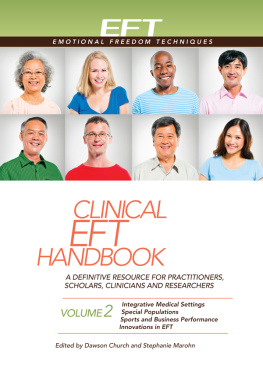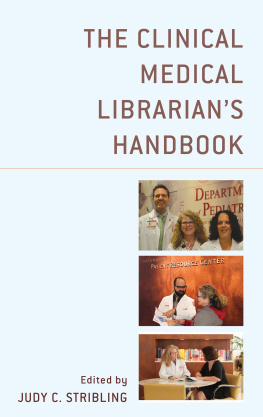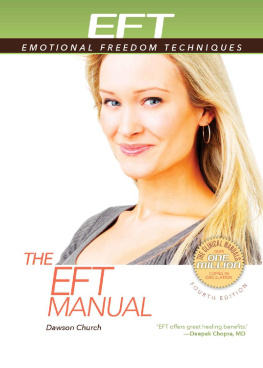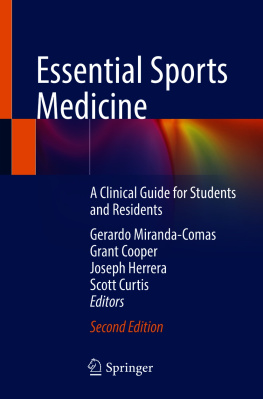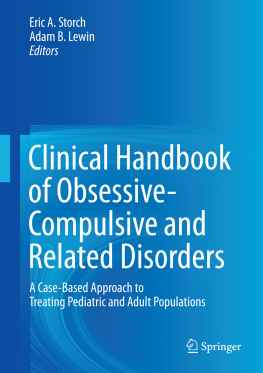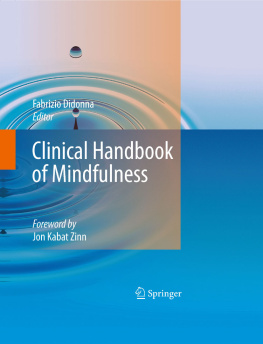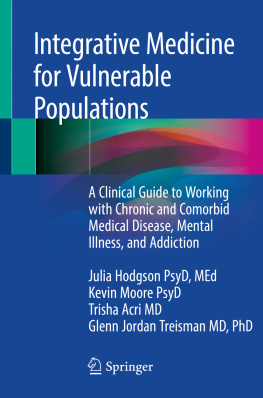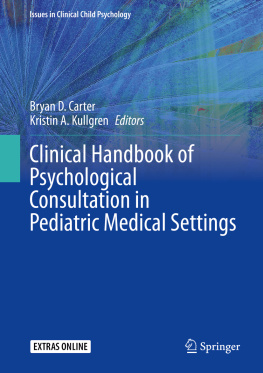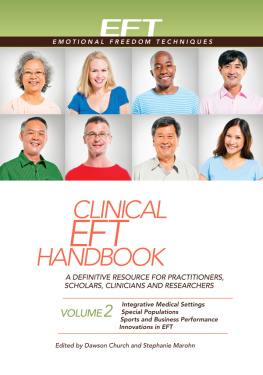Energy Psychology Press
3340 Fulton Rd., #442, Fulton, CA 95439
www.EFTUniverse.com
Library of Congress Cataloging-in-Publication Data
The clinical EFT handbook / edited by Dawson Church and Stephanie Marohn. First edition.
pages cm
multiple volumes
ISBN 978-1-60415-212-8
1. Emotional Freedom Techniques. 2. Emotion-focused therapy. I. Church, Dawson, 1956- editor of compilation. II. Marohn, Stephanie, editor of compilation.
RC489.F62C55 2013
616.89142dc23
2013038885
2013 Dawson Church
This book demonstrates an impressive personal improvement tool. It is not a substitute for training in psychology or psychotherapy. Nothing contained herein is meant to replace qualified medical advice. The author urges the reader to use these techniques under the supervision of qualified therapist or physician. The author and publisher do not assume responsibility for how the reader chooses to apply the techniques herein.
All rights reserved. No part of this publication may be reproduced, stored in a retrieval system, or transmitted in any form or by any means, electronic, mechanical, photocopy, recording, or otherwise, without prior written permission from Energy Psychology Press, with the exception of short excerpts used with acknowledgement of publisher and author. Clinical EFT is a registered trademark belonging to Energy Psychology Press.
Cover design by Victoria Valentine
Editing by Dawson Church and Stephanie Marohn
Typeset by Medlar Publishing Solutions Pvt Ltd, INDIA
Printed in USA by Bang Printing
First Edition
10 9 8 7 6 5 4 3 2 1
Chapter 47, EFT for the Beginning of Life: Supporting Wholeness, Human Potential, and Optimal Relationships, is included by permission of the author, Wendy Anne McCarty, PhD, RN, and Wondrous Beginnings Publishing, copyright 2013.
Chapter 53, Group Energies and Sports: Some Preliminary Speculation and Research, by Eric Leskowitz, is adapted, with permission, from an article that originally appeared in Spirit of Change magazine, Spring 2009.
Important Disclaimer
While EFT (Emotional Freedom Techniques) has produced remarkable clinical results, it must still be considered to be in the experimental stage and thus practitioners and the public must take complete responsibility for their use of it. Further, the authors offer the information in this book solely as their opinions. Readers are strongly cautioned and advised to consult with a physician, psychologist, psychiatrist, or other licensed health care professional before utilizing any of the information in this book. The information is from sources believed to be accurate and reliable and every reasonable effort has been made to make the information as complete and accurate as possible, but such completeness and accuracy cannot be guaranteed and is not guaranteed. The authors, publisher, and contributors to this book, and their successors, assigns, licensees, employees, officers, directors, attorneys, agents, and other parties related to them (a) do not make any representations, warranties, or guarantees that any of the information will produce any particular medical, psychological, physical, or emotional result; (b) are not engaged in the rendering of medical, psychological, or other advice or services; (c) do not provide diagnosis, care, treatment, or rehabilitation of any individual; and (d) do not necessarily share the views and opinions expressed herein. The information in this book has not undergone evaluation and testing by the United States Food and Drug Administration or similar agency of any other country and is not intended to diagnose, treat, prevent, mitigate, or cure any disease. Risks that might be determined by such testing are unknown. The information is provided on an as is basis without any warranties of any kind, express or implied, whether warranties as to use, merchantability, fitness for a particular purpose, or otherwise. The authors, publisher, and contributors to this book, and their successors, assigns, licensees, employees, officers, directors, attorneys, agents, and other parties related to them (a) expressly disclaim any liability for and shall not be liable for any loss or damage including but not limited to use of the information; (b) shall not be liable for any direct or indirect compensatory, special, incidental, or consequential damages or costs of any kind or character; (c) shall not be responsible for any acts or omissions by any party including but not limited to any party mentioned or included in the information or otherwise; (d) do not endorse or support any material or information from any party mentioned or included in the information or otherwise; and (e) will not be liable for damages or costs resulting from any claim whatsoever. If the reader or user does not agree with any of the terms of the foregoing, the reader or user should not use the information in this book or read it. A reader who continues reading this book will be deemed to have accepted the provisions of this disclaimer.
David Lake
Abstract
This chapter is a general overview, purely from my personal experience, of utilizing meridian stimulation (tapping) in medical practice. As one of the relatively few medical practitioners doing this, I report on my own 14 years of intensive experimentation, workshop teaching, and supervision in this new field of energy psychology. It has changed my life personally and professionally because of its compelling results. I am not being comprehensive in this chapter but wish to inspire others to try it out, and investigate further. I find tapping to be a valuable resource in physical and emotional healing. As an alternative treatment from the world of natural medicine, it can find a place as a powerful relaxation technique, a self-soothing and stress-management technique, a unique and ideal treatment partner for anxiety, fear, and trauma, and a useful tool for helping to process negative emotions. As well, it can have beneficial results for any condition by helping the mind-body function optimally, in the best balance. It is a partner for most general therapy modalities. It is ideal as self-help in any situation. And it is simple, safe, and easy to learn and do. Tapping provides the best example, in my life as a doctor, of a technique that brings the best of natural and orthodox medicine togetherwhere they belong.
Keywords: continuous tapping, integrative medicine, natural medicine, CBT, PTSD, anxiety, phobia, depression

David Lake, a medical practitioner and psychotherapist in private practice since 1977, has extensive experience in helping people overcome the effects of posttraumatic stress. Dr. Lake also has considerable expertise in assisting couples and individuals with relationship problems. He is the author of four books on energy psychology. Send correspondence to David Lake, PO Box 738, Newport, NSW, Australia 2106, or dlake@optusnet.com.au. www.eftdownunder.com.
Introduction for Doctors
I write this as a doctor who practiced as a general family physician for 25 years and gradually moved afterward to full-time psychotherapy and energy psychology. This shift happened because of my interest in treating the ever-present anxiety I saw in ordinary people with illness. It is fair to say that I had little to offer anxious patients early on, other than reassurance. I explored the world of innovative psychological treatments purely from the criterion of practical effectiveness; I am only ever interested, then and now, in what actually works in the real world. I have thus had severe disappointments in my investigations of standard psychological approaches, as well as many traditional talking therapies. Other modern techniques were effective, although no one technique can do everything. But the moment I was introduced to EFT remains in my mind as a watershed in my career. EFT is both highly effective and easy to learn and use.

